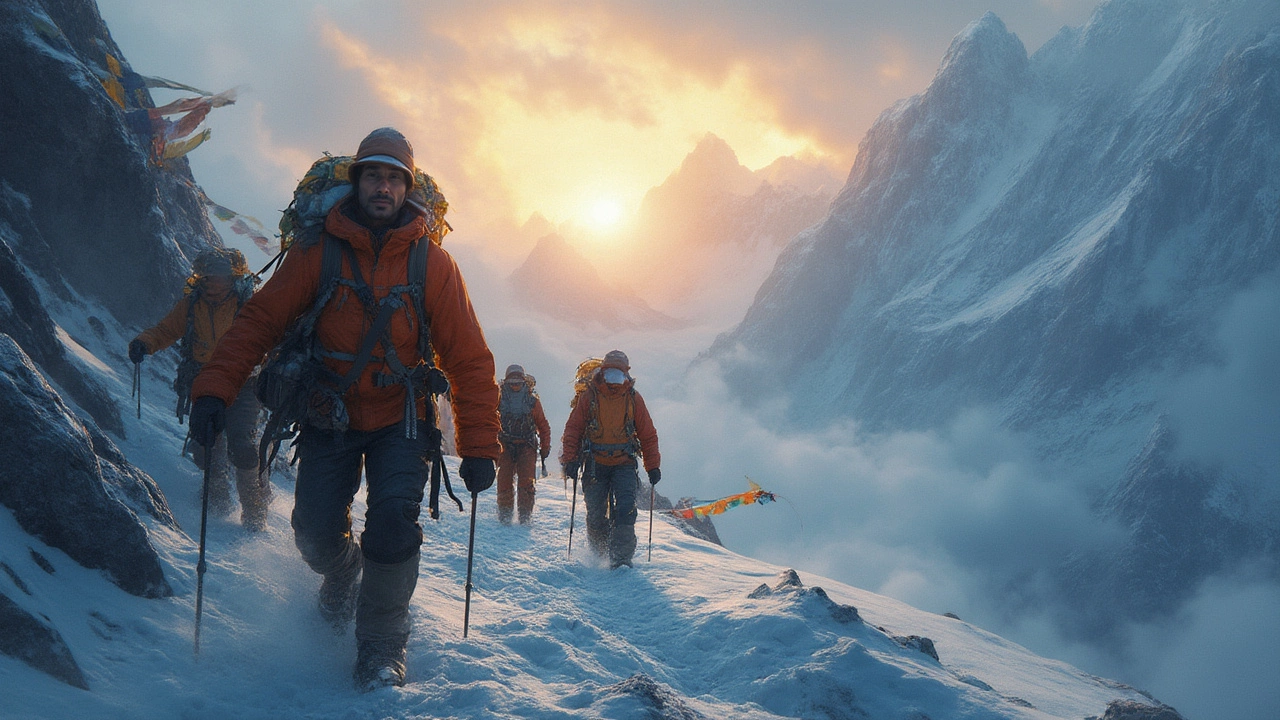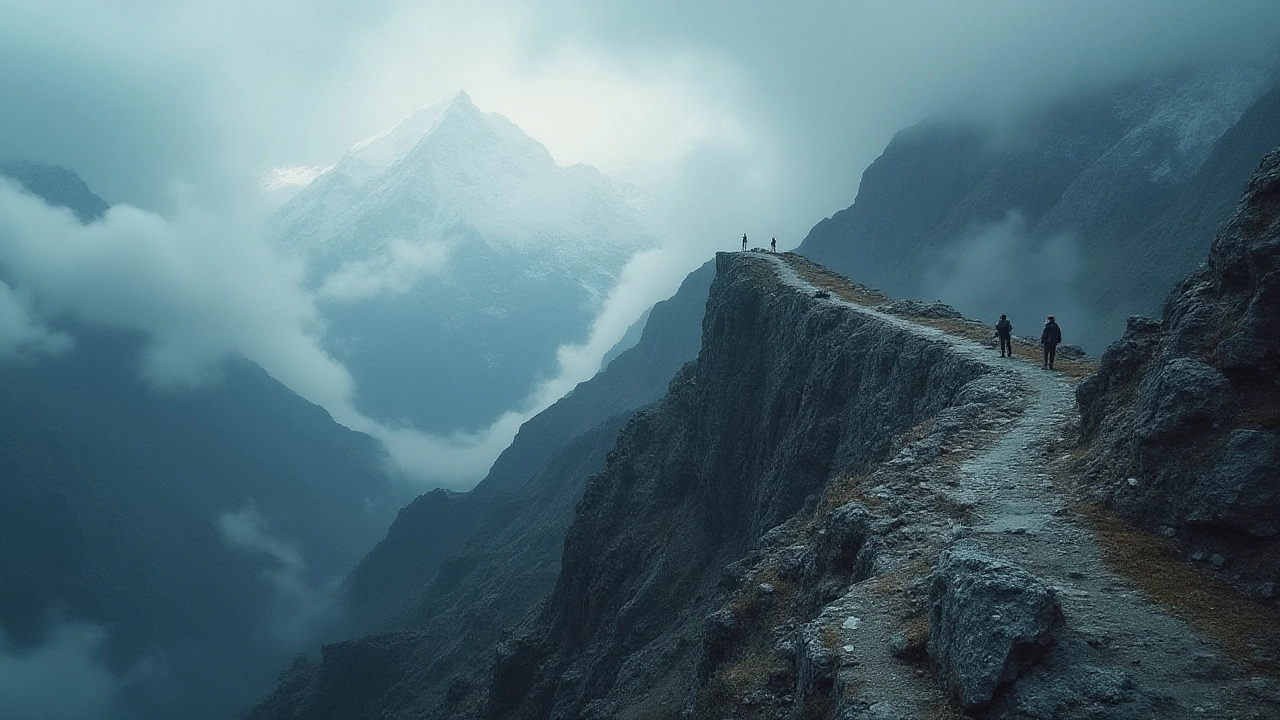World's Hardest Trek: Conquering the Hardest Trekking Trails
 Jul, 19 2025
Jul, 19 2025
If trekking had a crown jewel for suffering and triumph, it’s hard to look past a handful of legendary routes. Ask any serious hiker and you’ll get a wild range of answers, each with their own horror stories and triumphs. But only a few names make your palms sweat before you’ve even reached the gear shop. In mountaineering circles, one trek draws the kind of awe usually reserved for astronauts. Can you guess it? I’ll get straight to it: the Snowman Trek, high in the Bhutanese Himalayas, is widely regarded as the hardest trek in the world. And wow, does it earn that title.
What Pushes the Snowman Trek to the Top?
Now, you might’ve expected an answer like the Everest Base Camp trek or maybe even something deep in the Andes. Those are both tough, but the Snowman Trek cranks up every dial—distance, altitude, weather, isolation—to new levels of agony and reward. Stretching roughly 300 kilometers (186 miles), this trek cuts across eleven high-altitude mountain passes, most of them over 4,500 meters (14,750 feet). That’s higher than you can drive in North America—higher even than most Himalayan valleys. The air up there is so thin, you’ll feel winded tying your boots.
One thing sets the Snowman Trek apart: its stubborn refusal to make anything easy. The route burns across isolated Himalayan villages, swinging close to the border with Tibet. It’s bitter cold, blistering hot, and so isolated you’ll only see a handful of other trekkers all season. Some years, only about 50 people manage to actually finish it! Weather is the chief villain. Sleet, snow, and fierce winds can barrel in, blocking high passes and forcing even the fittest teams to retreat. Even in good conditions, you’ll cross rickety log bridges, yak trails worn to mud, and deal with leeches, avalanches, and possible frostbite. Fancy a walk?
If you think you can just show up and hike, think again. The Bhutanese government limits access, aiming to protect fragile environments and local cultures. You need permits, guides, and serious logistical backup just to start. Supply runs involve yak caravans, as there’s nothing resembling a shop or phone reception for weeks. Forget hitching a ride out if you twist an ankle—rescue means a chopper, and that’s only if weather allows. Mental stamina counts just as much as brawn. Going bonkers from solitude is no joke, especially when you’ve only got powdered soup and instant noodles for comfort.
But for all its difficulties, the Snowman Trek dishes out sights so stunning you’ll be talking about them for decades. Think turquoise glacial lakes, snowy giant peaks, ancient dzongs (fortresses), and villagers still living much as they did centuries ago. Watching sunrise on Gangkhar Puensum—the world’s highest unclimbed mountain—is so surreal, it feels like breathing in a dream. Small wonder they call Bhutan the "Land of the Thunder Dragon."
Other Brutal Contenders Worth Mentioning
The Snowman Trek isn’t the only path to bragging rights. Quite a few trails have chewed up and spat out even seasoned trekkers. The Grand Himalayan Trail (GHT) in Nepal is a monster—clocking in at over 1,700 kilometers (1,056 miles). No one expects you to walk it in one go—it takes months and stretches from the subtropical jungles of East Nepal all the way to the arid cliffs of Humla, near Tibet. The GHT, though a network of lower and higher routes, is littered with risky river crossings, blizzards, and scree slopes that test your nerves day after day. Locals call parts of it the “corridor of storms”—pretty accurate after dark clouds move in uninvited.
Down in South America, the Huayhuash Circuit in Peru is like the Snowman’s sibling—shorter but with no less attitude. About 130 kilometers (81 miles) but nearly every day you’re hiking above 4,100 meters (13,450 feet). If you have trouble pronouncing “Huayhuash” with full lungs, try it while gasping at altitude! The weather’s unpredictable and temperatures plummet at night, sometimes below freezing, even in “summer”. There’s no easy way in or out, making self-sufficiency key and rescue a technical challenge.
Let’s talk about the Drakensberg Grand Traverse in South Africa/Lesotho. It’s an unmarked trail—“trail” might be generous—running at high altitude for 220 kilometers (137 miles) across misty escarpments and river gorges. There’s zero official navigation help: you rely on map and compass, and hope you don’t fall from the dramatic basalt cliffs. Add rogue weather and hungry leopards lurking nearby and you’ve got a wild ride ahead. Every year, even local guides get caught out by surprise thunderstorms.
I can’t skip the Kungsleden (“King’s Trail”) in Sweden; while not as high, it can be grueling in winter. The classic 440-kilometer (273-mile) northern section is prone to white-outs and requires backcountry skiing skills. In places the sun never rises in winter, and huts are a day's slog apart. If you lose your way during a blizzard, you may run into real danger. There’s nothing like waking up to see the aurora through your frosted tent—if you manage to fall asleep in the first place.

Stories, Challenges, and Triumphs on the Hardest Treks
Every few years, stories surface of trekkers dropping out—or worse—on the Snowman and other brutal hikes. In 2019, a veteran Himalayan guide shared that he’d led fewer Snowman groups than Everest summits, simply because so few people finish. It’s not rare for treks to end early in whiteouts or because yaks refuse to cross creaking bridges. In 2022, a British team camped for three days waiting for a rescue heli after a teammate broke his ankle near Gophula Pass, marooned in heavy snow. Survival meant rationing food, melting snow for water, and radioing in their predicament—there are no search and rescue teams “on duty” in these remote spots.
Then you have the good stories—the “I made it” grins. A group of Canadians once finished the full Grand Himalayan Trail in 120 days, hauling every gram of food and gear, losing almost a quarter of their body weight. They blogged every day about freezing glacial rivers, the best momos (Himalayan dumplings) they found in lonely villages, and the wild welcome of local herders as they crossed into new valleys. If you make it back in one piece, stories take on a life of their own—rain that “turned the path into chocolate porridge,” boots “falling apart at pass number seven,” and that weird but magical taste of yak butter tea at a freezing dawn.
If you’re having a bad day on trail, what keeps you moving? Sometimes it’s pure stubbornness. Trekkers talk about using “micro-goals”—get to the next rock, then the next boulder, repeat every hour for days. Others leave motivational notes in pockets. (I once wrote my daughter Aria's name on my water bottle—worked like a charm.) Trekking is less about muscle and more about mood, mindset, and not giving up when nature throws a tantrum. Watch out for altitude sickness, the real equalizer. No fitness level guarantees you’ll avoid it. Watch yourself, take it slow, and don’t ignore tingling fingers or a crushing headache. Your pride can wait—turning back sometimes is the tougher, wiser decision.
What about food? Most of the hardest treks require you to be your own chef, sherpa, and medic. Some folks swear by instant noodles spiced to the sky, others bring elaborate freeze-dried meals. If you have the chance, accept the hospitality of remote villagers: tsampa (barley porridge) in Bhutan or toasted corn in the Andes is richer than anything you’ll ever eat in an air-conditioned bistro. Carry enough calories—you burn through thousands per day at altitude. And don’t forget to filter that glacier run-off water. Nothing ruins a trek like a gut bug on day four.
Tips for Tackling the World's Toughest Treks
If you’ve read this far, maybe you’re either planning a brutal trek or just like living vicariously through the misery and glory of others. Either way, here’s the real advice: preparation isn’t just about packing socks and a waterproof jacket. These treks demand respect—body, mind, and gear must be ready for almost anything.
- Start slow, build stamina: Months before you leave, get used to hiking long back-to-back days with a heavy pack. Hills beat flat walks every time. If you struggle with local hills, the Himalayas or Andes will be eye-opening.
- Test your gear: Don’t let your first blizzard be the moment you find out your jacket leaks. Try every piece of equipment, from boots to water filters, in tough weather at home. If it fails locally, it’ll fail worse up high.
- Altitude readiness: You can’t train for altitude at sea level, but you can arrive fit and acclimate slowly. Add at least one extra day for every thousand meters over 2,500 meters. Don’t rush simple things: walk, rest, repeat.
- Logistics, logistics, logistics: Check permit rules, book guides well in advance, and carry backup batteries for GPS or satellite phones. Hard treks are often in places where the closest help is days away, so keep emergency contacts handy.
- Mental grit: The toughest days kill your motivation. Keep a personal picture or a song you like; break down the trek into small daily victories. If you hike with others, talk often, share snacks, and check on everyone’s mood. Staying positive can literally keep you alive.
- Smart packing: The perfect kit balances weight and comfort. Pack light, but never skip high-quality boots, a warm sleeping bag, and proper rain gear. Sunscreen and sunglasses are a must—the high-altitude sun burns faster than you think.
- Respect local culture and nature: Hard treks often cross villages where life hasn’t changed in centuries. Dress modestly, ask before taking photos, and try to learn a greeting or two. Carry out all your trash—no one is coming after you to clean up.
Perhaps the best tip is this: don’t be in a hurry to say you did the hardest trek just for bragging rights. The real rewards are slower moments—a sunrise that just rips through your soul, laughter with locals, and that insane sense of “I really did this” when you step off the trail. It’s about testing yourself in wild places, thinking less about conquering and more about surviving, learning, and seeing the world at its rawest. No Instagram shot or summit badge really captures it. There’s only you, sore feet, huge skies, and that endless path unfurled under your boots.